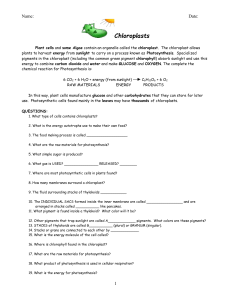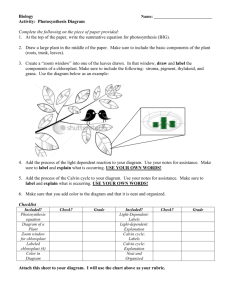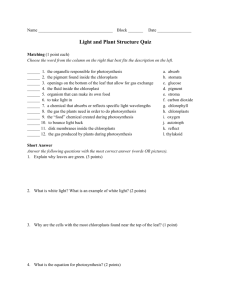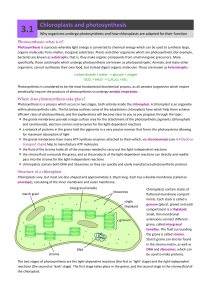Chloroplast Worksheets KEY
advertisement
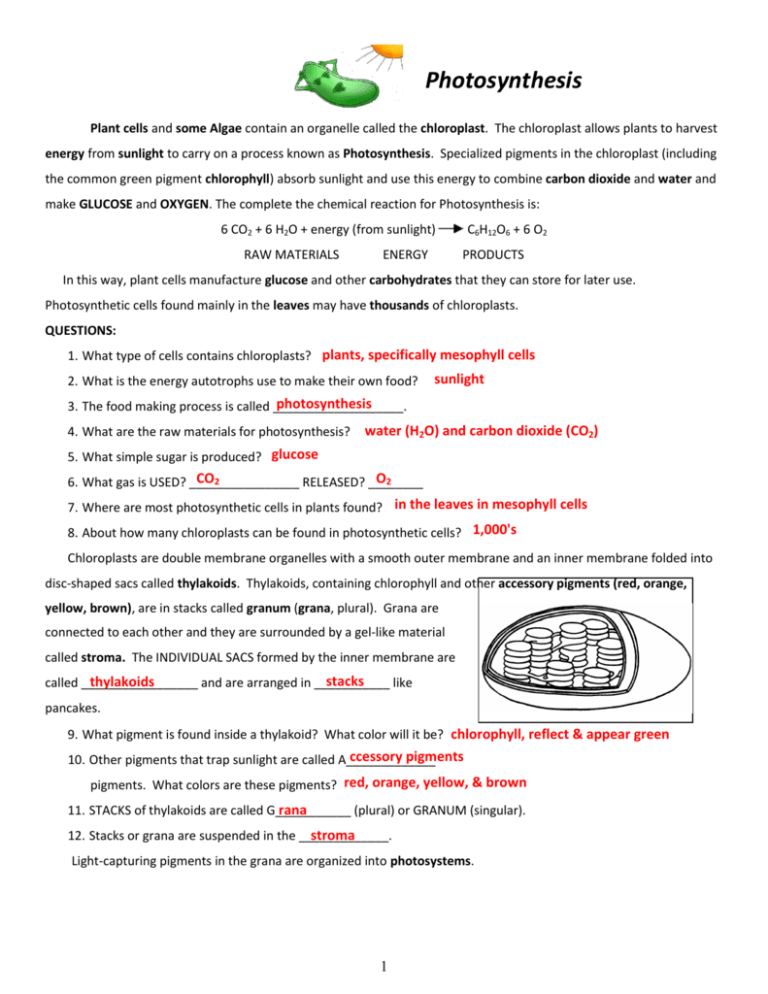
Photosynthesis Plant cells and some Algae contain an organelle called the chloroplast. The chloroplast allows plants to harvest energy from sunlight to carry on a process known as Photosynthesis. Specialized pigments in the chloroplast (including the common green pigment chlorophyll) absorb sunlight and use this energy to combine carbon dioxide and water and make GLUCOSE and OXYGEN. The complete the chemical reaction for Photosynthesis is: 6 CO2 + 6 H2O + energy (from sunlight) RAW MATERIALS ENERGY C6H12O6 + 6 O2 PRODUCTS In this way, plant cells manufacture glucose and other carbohydrates that they can store for later use. Photosynthetic cells found mainly in the leaves may have thousands of chloroplasts. QUESTIONS: 1. What type of cells contains chloroplasts? plants, specifically mesophyll cells 2. What is the energy autotrophs use to make their own food? sunlight photosynthesis 3. The food making process is called ___________________. 4. What are the raw materials for photosynthesis? water (H2O) and carbon dioxide (CO2) 5. What simple sugar is produced? glucose CO2 O2 6. What gas is USED? ________________ RELEASED? ________ 7. Where are most photosynthetic cells in plants found? in the leaves in mesophyll cells 8. About how many chloroplasts can be found in photosynthetic cells? 1,000's Chloroplasts are double membrane organelles with a smooth outer membrane and an inner membrane folded into disc-shaped sacs called thylakoids. Thylakoids, containing chlorophyll and other accessory pigments (red, orange, yellow, brown), are in stacks called granum (grana, plural). Grana are FIGURE 1-CHLOROPLAST connected to each other and they are surrounded by a gel-like material called stroma. The INDIVIDUAL SACS formed by the inner membrane are stacks thylakoids called _________________ and are arranged in ___________ like pancakes. 9. What pigment is found inside a thylakoid? What color will it be? chlorophyll, reflect & appear green ccessory pigments 10. Other pigments that trap sunlight are called A_____________ pigments. What colors are these pigments? red, orange, yellow, & brown rana 11. STACKS of thylakoids are called G___________ (plural) or GRANUM (singular). stroma 12. Stacks or grana are suspended in the _____________. Light-capturing pigments in the grana are organized into photosystems. 1 C Photosynthesis Crossword Review 4 / P H O T O S Y N T H O R G A N I E S L I G H T L H Legend: S I O X Y G E N / = a space between 2 words G L H A T P K W A T E S T R O M A / I G D D & B L U E R E U P U C H E M B O N I S P H O T O N S D E E C & N P H O T O R E S P I R A T I O N O T 2 C O 2 & W A T E R I O S M O S I S Across 2. The compounds that result from the Calvin Cycle, such as glucose are THIS 4. The light-dependent reactions REQUIRE THIS 7. The light-dependent reactions release THIS waste which humans NEED 8. The light-dependent reactions produce THIS energy molecule 9. Atmospheric oxygen occurs as a result of photosynthesis by the breakdown of THIS during the beginning of the lightdependent reaction 10. Inside chloroplasts, the fluid-like matrix in which the Calvin cycle occurs is called THIS 12. Chlorophyll is important to many plants because these pigments absorb THESE COLORS 13. During photosynthesis, ATP molecules are generated by THIS PART of Stage 2 14. Light energy reaches cholorophyll in tiny packets called THIS 15. Is an inefficiency of photosynthesis in hot, dry conditions in which O2 cannot be released and CO2 cannot enter the leaves to provide carbon to make glucose Down 1. is an adaptation to photorespiration where the calvin cycle occurs in deeper plant cells 3. THESE are SUBSTRATES for photosynthesis (light AND dark reactions – Overall equation) 5. The light reactions take place in the membrane of THIS 6. After the phosphate bonds are broken in ATP in the Calvin cycle, the ADP is recycled back to THIS 11. THESE are the main PRODUCTS of photosynthesis are (think of overall equation) 12. THIS is located in the Stroma as a part of the Calvin Cycle

